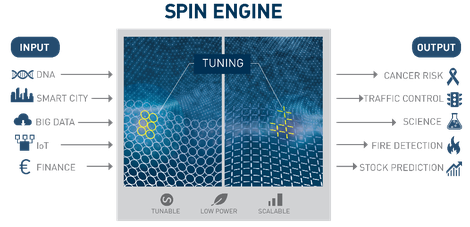Future and Emerging Technologies - SpinENGINE

Introduction
The SpineENGINE project (Harnessing the Emergent Properties of Nanomagnet Ensembles for Massively Parallel Data Analysis) coordinate by prof. Erik Folven of NTNU, Trondheim, Norway is a collaborative effort of 4 universities(NTNU, University of Sheffield, ETH Zurich, Ghent University) and one industrial partner (IBM). The projects runs from January 2020 till December 2023.
Project description
The SpinENGINE project will lay the foundations for a new, massively parallel, computational platform based on emergent behaviour in large nanomagnet ensembles. The project will develop an efficient, highly scalable, and easily reproducible platform meeting the data analysis challenges in our increasingly data-rich society. We will build upon our recent discoveries and use complex, nonlinear, and highly tunable interactions in such ensembles to realize a hardware platform for “Reservoir Computing”, a biologically-inspired computational approach. Our critical hypothesis is that the synergies between the inherent properties of nanomagnet ensembles and those required for reservoir computing will enable the efficient creation of a highly adaptive computational platform for the analysis of complex, dynamic data sets. This has the potential to greatly outperform current approaches using conventional CMOS hardware.
SpinENGINE will bring together a multidisciplinary team of researchers with expertise in computer science, condensed matter physics, material science, computational modelling, and high-resolution microscopy. This will enable us to simultaneously explore the fundamental behaviours of nanomagnet ensembles and understand how these can be harnessed for useful computation. By the end of the project, we aim to fabricate a proof-of-concept device capable of solving pattern recognition and classification problems, and, in collaboration with our industrial partner, IBM, produce a roadmap to the further scaling and commercialization of our computational platform. Success in the SpinENGINE project will have vast implications for data analysis at all scales, ranging from low power computation in the simplest sensor node to accelerated data processing in the most complex supercomputer.
Objectives
These are the objectives of SpinENGINE
- To establish protocols for reservoir computing based on nanomagnet ensemble behaviour, i.e. representing linear independent reservoir transfer functions with emergent ensemble properties and memory of past states through ensemble non-volatility.
- To identify the most suitable approach for tuning interactions between nanomagnets, i.e. determine the effectiveness of different external stimuli in tuning inter-element coupling with optimized element geometry, arrangement, and materials.
- To understand and demonstrate tunable emergent behaviour in nanomagnet ensembles, i.e. determine the sensitivity of emergent properties of large nanomagnet ensembles to external stimuli as well as lattice geometries, material compositions, local inhomogeneities, and boundary effects.
- To demonstrate computational functionality in nanomagnet ensembles. This will require demonstration of data read/write methods and integration of connections for read, write, and tuning operations on a large ensemble.
Website
to be announced
Contact
Prof. Bartel Van Waeyenberge
Department of Solid State Sciences
Phone number: +32 9 264 4366
E-mail
